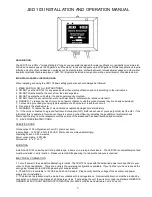
IM 12D08N05-01E
6-2
<6. CALIBRATION>
6.4 Sample calibration
With the sensor in situ, a sample can be taken for laboratory analysis. Sample calibration
records the time and reading, and holds these in memory until the analysis has been
completed. The laboratory data can then be entered regardless of the current process
value, without the need for calculations.
6.5 Temperature coefficient calibration
Simply input the solution conductivity at reference temperature (T
R
), after the sensor is
allowed to stabilize at elevated temperature. The SC450G will calculate the temperature
coefficient for you. The ideal temperature for this calibration, is the normal process value
(T
P
). For good calibrations, the minimum span (T
P
T
R
) should be at least 2ºC.
Note that the Temperature Compensation should be set to TC first.
6.6 Temperature calibration
In order to make the most accurate measurements, it is important to have a precise
temperature measurement. This affects the display of temperature, and the output signal
when used. More important, however, is the temperature compensation, and calibration
accuracy.
The temperature of the sensor system should be measured independently with a high
precision thermometer. The display should then be adjusted to agree with the reading
(zero offset calibration only). For best accuracy this should be done as near to the normal
operating temperature as possible.
6.7 Operation of hold function during calibration
SC450G has a HOLD function that will suspend the operation of the control/alarm relays
and mA-outputs.
During calibration, the user may choose to enable HOLD so that the output signals are
frozen to a “last” or “fixed” value. Some users will choose to leave the outputs “live” to
record the calibration event. This has implications for pharmaceutical manufacture, for
example, where an independent record of calibrations is mandatory.
Press HOLD button on main screen, to remove the HOLD.
The route for HOLD setup is
Commissioning >> Output setup>> Configure Hold
6.8 General comments on SC calibration
• SC sensors experience no drift except if they are damaged or dirty
• There are no good calibration solutions (like pH buffer solutions)
• Solution calibration of SC demands laboratory technical skills
• Solutions can be used to give a fair calibration check at higher conductivity
• Solutions can NOT be used to check calibration at low conductivity.
• Low conductivity solutions <10μS/cm absorb CO
2
from the air very fast
• Low conductivity measurement must be made only with air excluded
• Apparatus must be scrupulously clean to avoid contamination
• Sensor linearity is never a problem for lower values
• A dirty sensor is prone to polarization
Содержание Exaxt450
Страница 1: ...User s Manual IM 12D08N05 01E 5th Edition Model SC450G Conductivity Converter Style S2...
Страница 12: ...Blank Page...
Страница 58: ...Blank Page...
Страница 62: ...Blank Page...
Страница 79: ...IM 12D08N05 01E APP 13 APPENDIXES Appendix 7 Control drawing for FM approval...
Страница 80: ...Blank Page...















































